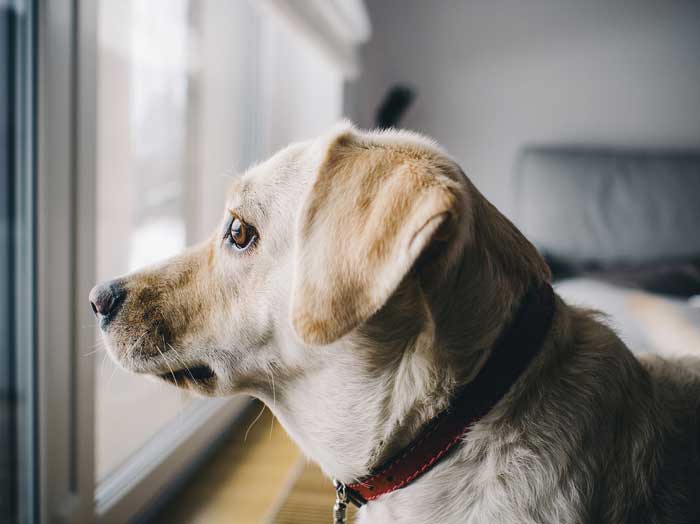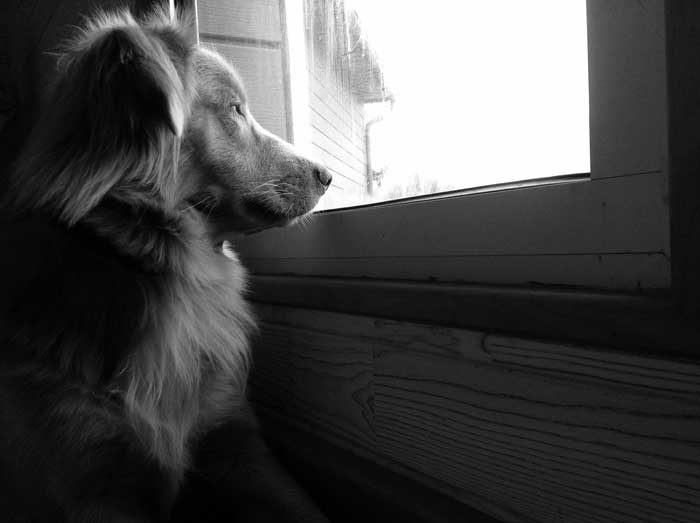Dogs, unfortunately, can suffer a specific type of anxiety that can be incredibly disruptive to those around them. This type of anxiety is called separation anxiety, and as you might be able to imagine, it occurs when a dog is separated from its owner.
Depending on the severity of the anxiety, your dog might be fine with you going out to the store for a short bit of time, or you might not be able to leave your house without causing your dog immense stress.
Understanding what separation anxiety is can help you know how to calm your dog down.
What Is Separation Anxiety?
As the name suggests, separation anxiety is a type of anxiety that surrounds the dog being separated from its owner.
Sometimes, rescue dogs will have bad cases of separation anxiety, usually because their owners left them and never returned.
Other dogs simply never learned to cope with the owner being away for long periods of time, meaning that having the owner leave is a concept that they never knew.
To the dog, when you leave the house, it isn’t known that you will ever return again.
To a dog who depends on the owner and looks up to you, as the owner, as the alpha of the household, this is a truly terrifying concept. This is why separation anxiety usually has such a destructive take for dogs.
By understanding what separation anxiety is, you can start taking the steps needed to know how to help a dog with separation anxiety.
What Does Separation Anxiety Look Like?

Most forms of anxiety in dogs take place as pacing, whining, and barking.
However, with you not there to take notice of this behavior and put a stop to it, separation anxiety can escalate to extremely destructive levels.
For example, they will urinate and defecate all over the house when left alone for too long. As long as your dog isn’t doing this when you are around, it is usually a symptom of your dog’s separation anxiety.
It can mean that you are in for a nasty surprise when you do finally arrive home to your dog.
While this might not affect you as much when you are not there, a dog’s constant barking and howling can affect neighbors, both on the sides of your home and (if applicable) upstairs and downstairs neighbors.
When left alone for too long, a dog with separation anxiety will begin to bark and howl, seemingly calling for its owner to return.
Some dogs will try to escape from the area they are kept in. Depending on where the dog is being kept, this means that it will be trying to chew and dig its way through doors, windows, gates, and just about anything in its way.
Not only does this pose a huge risk if your dog does get out, but it can also result in injuries as well.
The most destructive form of your dog’s separation anxiety is the way that it will chew, dig, and destroy anything and everything that it can.
This can range from the furniture in your house to the walls and even fragile objects.
Not only does this literally destroy your property, costing you hundreds and potentially thousands in repairs, but it can also damage your dog as well, which is something that no dog owner wants to have happen.
All of these aren’t good for your dog or your home, making it all the more important for you to learn how to treat the separation anxiety and teach your dog that it is okay for you to leave the house.
There are different ways to handle different severities of separation anxiety, with the more severe types of separation anxiety having the most drastic treatments.
How Do You Handle Minor Separation Anxiety?
Handling minor separation anxiety is relatively easy, and it becomes easier with the milder your dog’s anxiety is.
While you are gone, you can make sure that you leave your dog with a pile of clothes, preferably recently worn. When the clothes are recently worn, they will carry your scent on them.
This can be comforting to a dog that suffers from separation anxiety, and in cases where the anxiety is mild, it can keep them calm.
When you do return home, make sure that you don’t make a big deal about being back home, as this will reinforce the idea that leaving is a big deal in your dog’s mind.
While your dog is jumping up, overjoyed that you have returned, you should ignore the dog for the first few minutes. After those minutes are up, calmly pet the dog, as if you had been home the whole day.
Doing this helps your dog realize that you leaving the house isn’t a big deal and isn’t something worth freaking out over.
As you continue to do this, your dog will eventually come to realize that you do come home eventually, which will reduce the effects of separation anxiety.
When you are away, you can also make sure that your dog learns to associate the fear of you being gone with the reward of having something good happen.
This is a process known as counter conditioning and it can be used on dogs with relatively mild separation anxiety to not only distract them for a fair bit, but also help them learn to associate you being gone with good things happening.
For this, you will either need a puzzle toy that your dog enjoys, or a special dog toy that rewards food to your dog if it can get it out, such as KONGs.
Make sure that these toys take about 20 to 30 minutes for your dog to get through. For the KONGs, you can even freeze them to make them last even longer than they normally would.
Inside those toys, you should put some special treats that your dog rarely gets, but dearly loves.
Low-fat peanut butter, frozen banana, cottage cheese, low-fat cream cheese, and spray cheese are all some treats to consider, as well as some types of meats.
Having such special treats inside these toys will help your dog better associate being alone with good things happening when it focuses on the toy, rather than the fact that you are not there.
You should give your dog that treat and make sure that it is playing with it right before you leave to ensure that your dog is focused on it, rather than you.
When you get back, immediately take the toy and put it in a place where your dog won’t ever be able to get it. Only giving your dog this toy when you are away helps to preserve its importance in having good things happen when you are not there.
Keep in mind that this will only work for dogs with mild separation anxiety. When your dog has a worse case of separation anxiety, it will not eat or play with toys, making the last method of keeping your dog calm useless.
There are other ways to help a dog that has severe separation anxiety.
How Do You Handle More Severe Cases of Separation Anxiety?

When it comes to handling a case of severe separation anxiety, there’s a bit more that you have to do to ensure that your dog does not destroy your entire house when you go to the grocery store.
The most effective thing that you can do is give your dog cues. This process takes time and patience, but it is well worth it in the end when you can return home to an eagerly waiting dog.
If you notice that your dog even gets anxious when it sees you preparing to leave, you will want to set up a pre-departure cue.
Next, you will want to start with very short absences, or depending on your dog’s anxiety, even just being out of sight in the next room.
As time goes on, you can progress to leaving for longer periods of time, and you might have to combine some methods of keeping your dog calm, but you will eventually be able to leave the house without worrying about how it will look when you come back.
What Is a Pre-departure Cue?
Keep in mind that you will only really have to do pre-departure cues if you realize that your dog gets anxious when it sees you preparing to leave.
If your dog can handle seeing you prepare to leave, you can skip to the next step, although reading this can sometimes help you handle your dog.
A pre-departure cue is not actually a cue you give to your dog to do something, but it is actually a desensitization method. Desensitization refers to exposing your dog to something it fears enough times that it no longer fears it as much.
There are many cues that people give off when they prepare to leave. It might be putting on a coat or a hat. It might be grabbing a purse off the table. It could even be picking up your keys or putting on shoes.
Once you figure out which of these cues triggers the pacing, whining, and panting in your dog, you can begin desensitizing your dog to that cue.
First, you will want to perform the cue. For example, if the cue is putting on your coat, you will simply want to put on your coat. The twist is that you aren’t leaving the house. Once your coat is on, sit down elsewhere in the house and go on with your life.
You should do this several times a day. Doing this will ensure that your dog will eventually realize that these cues don’t always mean that you are going to be leaving.
For dogs with extreme separation anxiety, this can help take a bit of the edge off when you do finally leave, as your dog won’t already be stressed out as much by seeing the pre-departure cue.
Next, Start with Short Absences

The length of the absences will depend on the severity of your dog’s anxiety. If your dog can’t even stand to see you leave the room, you can probably start these absences by going into another room in the house and closing the door so the dog can’t get in (although you should find a way to protect the door).
If your dog can handle you being outside the house for a few minutes, you could consider getting the mail, or walking the perimeter of the house, although you should keep the blinds shut so your dog can’t see you.
In the beginning, you will want to plan these absences to be shorter than the amount of time it takes for your dog to start being anxious.
It will be a bit tedious at first, but it will be worth it to not have an anxiety-ridden dog awaiting your return home by destroying your house.
To begin, you will first do out-of-sight stays in your own home. This is simple, as it involves you getting your dog to stay put in one room where they can’t destroy too much, such as the bathroom, and you are going to the other side of the door.
Keep doing this, maybe a few times each day, gradually increasing the amount of time that you stay “hidden” behind the bathroom door.
Always make sure that your dog is relaxed before you work on the next separation. Waiting a few minutes and calmly petting your dog can usually do the trick to calm it down.
At first, the absences will be as short as a few seconds, which might seem silly to you, but to a dog that has severe separation anxiety, it can be nerve-wracking.
When you do this until your dog can last around 10 seconds, you can then begin incorporating the KONG filled with a treat into the mix. This toy will show your dog that it is a safe separation and that you will return.
Eventually, you will want to move to doing this at exit doors, such as the back door of your house. In fact, if you usually leave through the front door, do these exercises at the back door, and vice versa for leaving through the back door.
Over time, you will want to increase to 40-minute absences, as separation anxiety does its worst within that time frame.
If your dog can handle the first 40 minutes, there’s a good chance that the damage caused will be reduced significantly. Typically, this entire process can be accomplished in a matter of weeks.
Final Thoughts
There are a few ways to handle separation anxiety in dogs, although it will take time and patience.
Never, ever, get mad at your dog for being anxious, as it physically cannot help it.
When you can, you should always try to take your dog with you or have a friend, family member, or dog sitter take care of your dog when you leave to curb the anxiety as best as you can.
You can also talk to a vet and behavioral specialist about anxiety medication and therapy to help with severe cases of separation anxiety.

